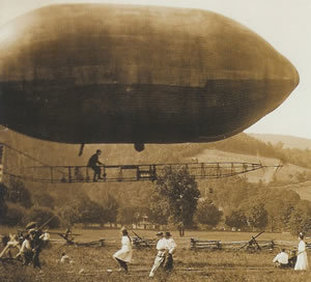 I grew up near the Goodyear Airdock in Akron, Ohio. Blimps were a common sight above our house. I was too young to know the part they'd played in wars for more than a century when they were called airships or dirigibles, or that "balloons" first ascended in France in the 1780's. While researching Yours in a Hurry I came to appreciate how so many dedicated lighter-than-air aeronauts became some of the first successful heavier –than-air (or aeroplane) flyers—or aviators as they were eventually called. Cromwell Dixon was profiled in an earlier blog. Two other examples follow.  GlennCurtiss Photographs of Curtiss show a slender, sober-faced, young professor-looking type with a mustache. He's often balancing on a bicycle or motorcycle, piloting a dirigible, or sitting in an aeroplane. He excelled at building and competing with all four. His father died when he was young. The self-taught engineer left school when he was fourteen to build bicycles, and then later motorcycles with his own motors. He came to national attention in 1907 when newspapers named him "the fastest man in the world" for setting a world record of 136.36 miles per hour in a motorcycle of his own design. You can see the motorcycle in the Smithsonian Institution. He soon began selling his motors for airships and then became an aeronaut (photo above) until he was introduced to aeroplanes. His first venture was with Alexander Graham Bell's Aerial Experiment Association. The collaboration's experiments started in Bell's summer home in Nova Scotia, but soon moved to better climate conditions in Curtiss's home town of Hammondsport, New York. A. Roy Knabenshue Knabenshue was raised in Toledo, Ohio. He came to national attention in his first successful flight navigating and setting a world altitude record in the California Arrow at the 1905 St. Louis World's Fair (photo left). After participating in the 1910 American international air show at Dominguez Hills, California as an aeronaut, he decided to move on to the new technology and learned to fly. After seeing his promotional talent in helping to plan and publicize the Dominguez Hills event, the Wright Company hired him later that year to manage their newly formed exhibition team. But, he remained interested in airships, building the White City in 1913, the first passenger dirigible in America. To find out more about early aeronauts, go to the Lighter Than Air Society website or contact The Bookseller in Akron, Ohio an antiquarian bookstore specializing in aviation. Sources: Early Birds of Aviation http://www.earlyaviators.com Wikipedia https://en.wikipedia.org/ Photo credits: Curtiss: Glenn Curtiss Museum Knabenshue: Library of Congress Collection, 8-14-06, Stereo copyrighted by C.L. Wasson Next time: American's have always taken pleasure in dining out.
0 Comments
Leave a Reply. |
Archives
August 2020
Categories
All
|
 RSS Feed
RSS Feed